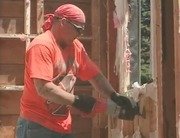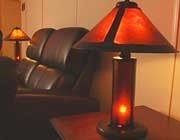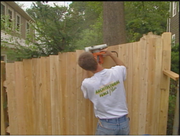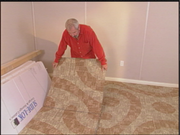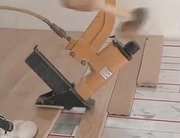Hi, I'm Bob Vila.
Welcome to the show here in Melrose where our basement finishing project is nearly complete.
Today we are going to be recapping how we keep the moisture out of this space down there.
But we are also be shopping for appliances laundry equipment and the like, putting in a fabulous Bose AV system, and some window treatments like we never seen before.
Stick around.
One of the key things about refinishing a basement is to make sure that it's going to be dry and then warm.
So we've got together with our friends from Basement Systems.
We couldn't have done it without them.
Lots of measures here to kind of waterproof this basement area, and this is the latest.
Right.
This is an underlayment, right?
It is.
It's a plastic sub floor made specifically for basements.
And , you know, in a basement it's very important that we don't have organic material on the floor, because we have water vapor coming up through concrete that's porous, and we don't want to have mold underneath the floor.
Now, before we got this far, let's just recap some of the methods that have been used for water proofing this basement.
The first things that we did involved a perimeter drain system.
You want to recap that for us?
Yeah, in order to keep the floor dry, and to drain water from the floor and the walls, the first thing that we did was put a perimeter drain in.
What we did was take all that water from the perimeter drain to a sump location The sump system we installed is called the TripleSafe because it has three pumps in it.
You have an AC pump, you have an AC backup, and a DC a battery backup pump.
So you're covered in all cases.
You're not going to be flooded from pump failure.
OK.
So we've got the lid on it and we are just adding more crushed stone to secure it.
But there's always going to be some standing water in that.
Isn't that a problem?
Normally it would be, but this sump system has an airtight lid on it, so that's full of water that's sitting there all the time.
It doesn't evaporate.
So, it can't evaporate back in, all right.
Yeah.
And we've also included an air tight floor drain in the sump lid.
So this way, if there was a plumbing leak from any plumbing source in the house, it would run to this low spot and then run down this floor drain which lets water down, but damp air cannot come up, because it has a cup and check ball underneath that floor drain.
So you've thought of everything.
We try.
But what about if you run out of power, and you go on battery power.
Well, that's important that the home owner knows that they're on the battery power.
So this is the charger box and control box for battery backup pump.
And we're gonna mount this on the wall up there.
And there's a loud alarm that sounds off when the home owner is on battery power to tell them, hey, you've got to restore these primary pumps before the battery goes dead.
Ok.
It seems like you've thought about everything.
But there's gotta be some other potential problems down the line.
I mean, you're taking all the water that collects here up and then through and between the sealing joints to an outside location.
What about the issues of freezing?
Yeah, that's an important issue, too.
And we have the solution to that.
They're called ice guard fittings, and we've mounted them outside already.
And this is all kind of aimed at controlling any water infiltration from underground.
Right.
Right.
It's rainwater what you're particularly concerned about.
out when it rains a lot the back fill gets saturated on the outside of the foundation.
It creates a little hydrostatic pressure, pushes water through the walls and up at the floor wall joint.
Terrible, terrible thought.
And then, speaking of the walls, an older house like this, it's not quite a century old, but still the quality of the foundation walls is not what you'd expect in today's homes where you have a uniform concrete floor.
Here it's kind of a punky and rubble stone and...
Right.
What have we done to deal with water infiltration through the walls?
Well, what we wanted to do was create a vapor barrier on the inside of the walls to prevent water vapor from evaporating into the basement environment, and we wanted to drain any leaks that come through the walls, down into the perimeter drain without being exposed to the basement environment.
So we put a product called Cleanspace, which is a reinforced vapor barrier, on the walls and tucked it down into our perimeter drain, so we take care of those.
And what about other issues like appliances that, like the water heater ,for example, if it should fail and it' s now in a finished basement.
What we've done there is we've installed a ring, called a flood ring, around the water heater that will drain water away into our perimeter drain.
In the event, well, the eventuality that the water heater would leak or any of the fittings associated with it would leak.
Okay, then the last question is, very often people have to go down and buy a dehumidifier even though they've taken all these measures to control moisture.
They still feel there's damp in there.
That's right.
And the furniture's going to get ruined or whatever , or mold growth.
What do you suggest in terms of dehumidifying space?
Well, you need a dehumidification system that's made for basement environments.
Most dehumidifiers are rated at 80 degree, 60 percent relative humidity.
And at 80 degrees it's easy to take water out the air because you cool it a little.
A little bit and you get condensation.
But in basements we have temperatures that are much cooler, maybe sixty two degrees, sixty five degrees.
Yep.
And we need a dehumidifier that is made for that environment.
And here we've installed what we call a Sanidry Basement Air System, and it is a one hundred pint per day dehumidification system.
It has air filtration built-in.
It's very energy efficient, in fact, it's Energy Star rated.
And it will perform very, very well in basements that have the cool temperatures.
Thanks, Larry.

